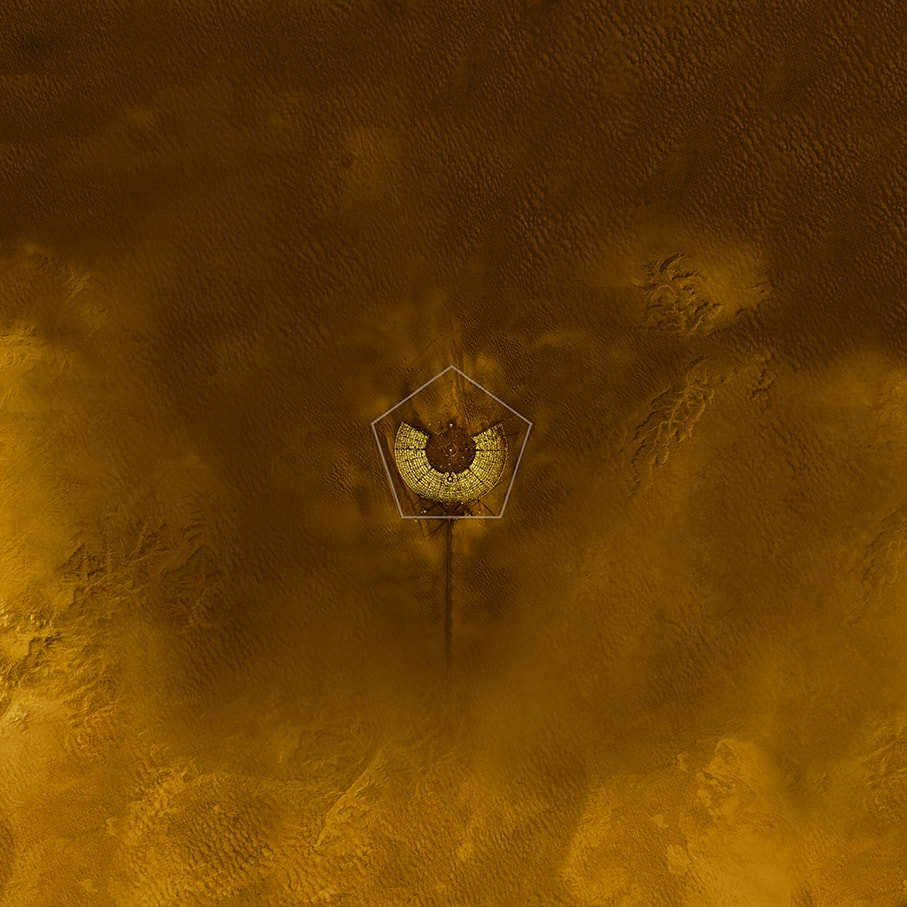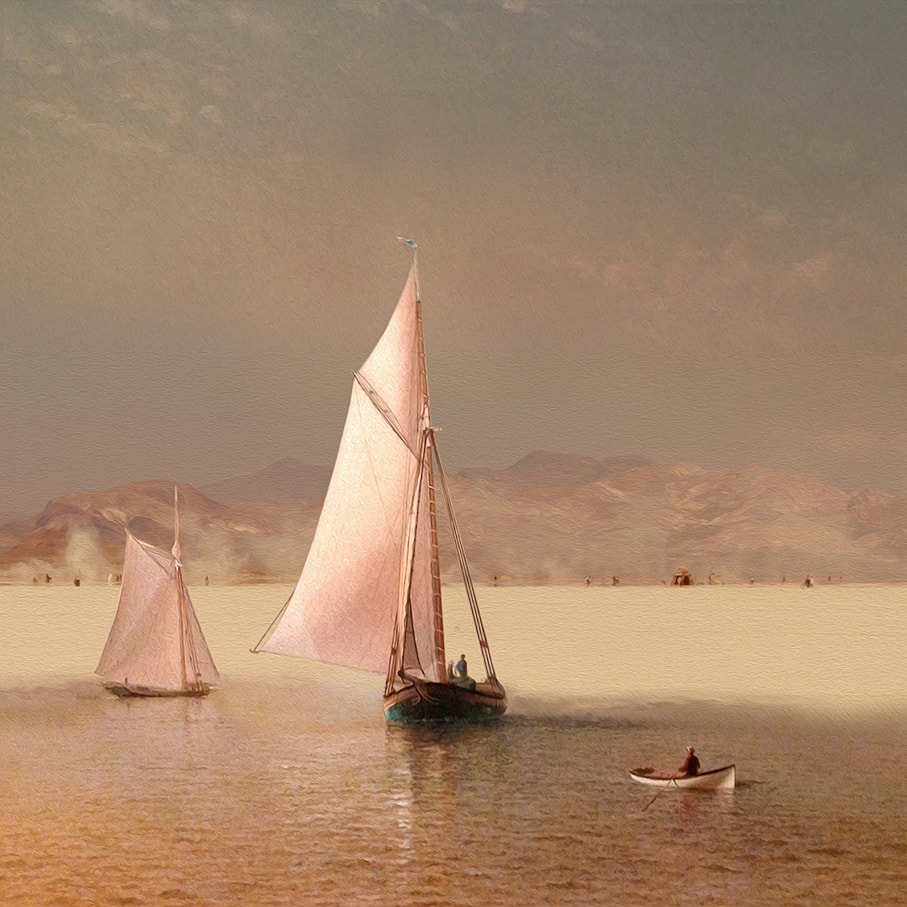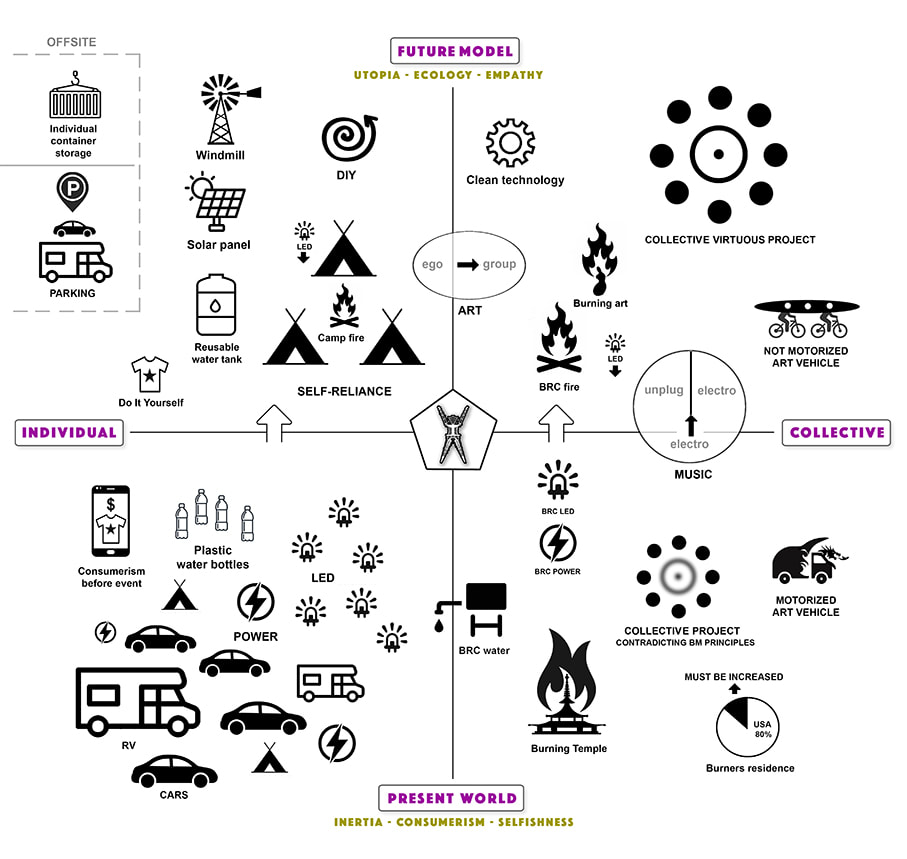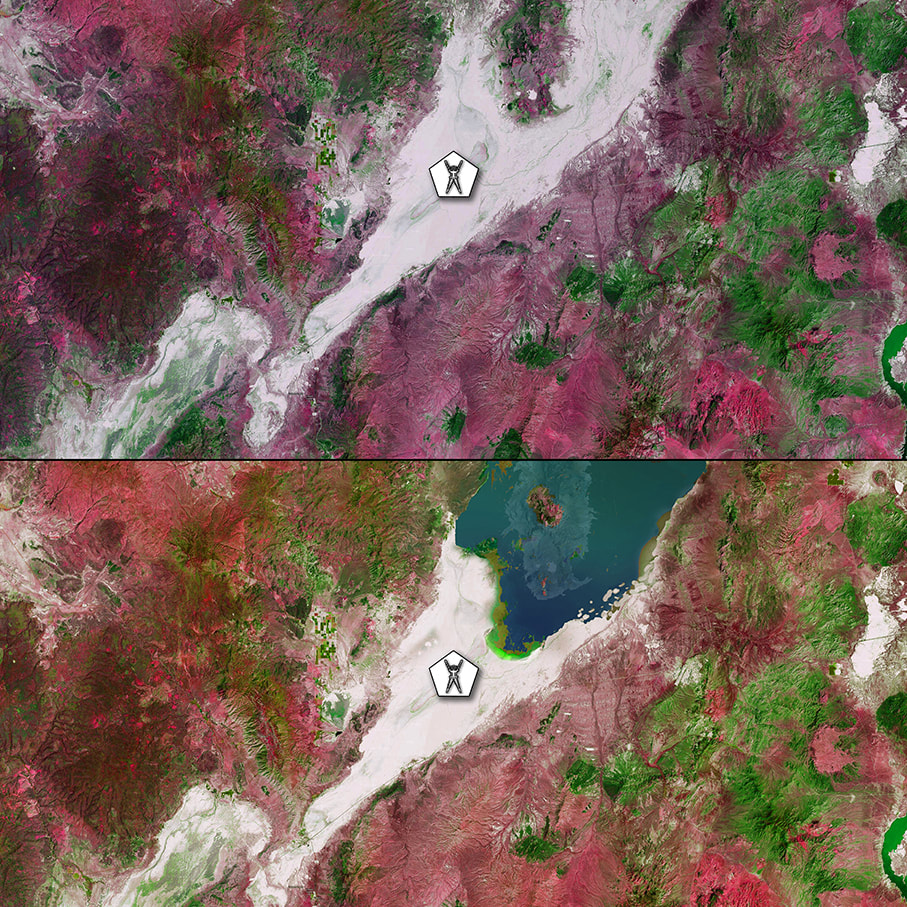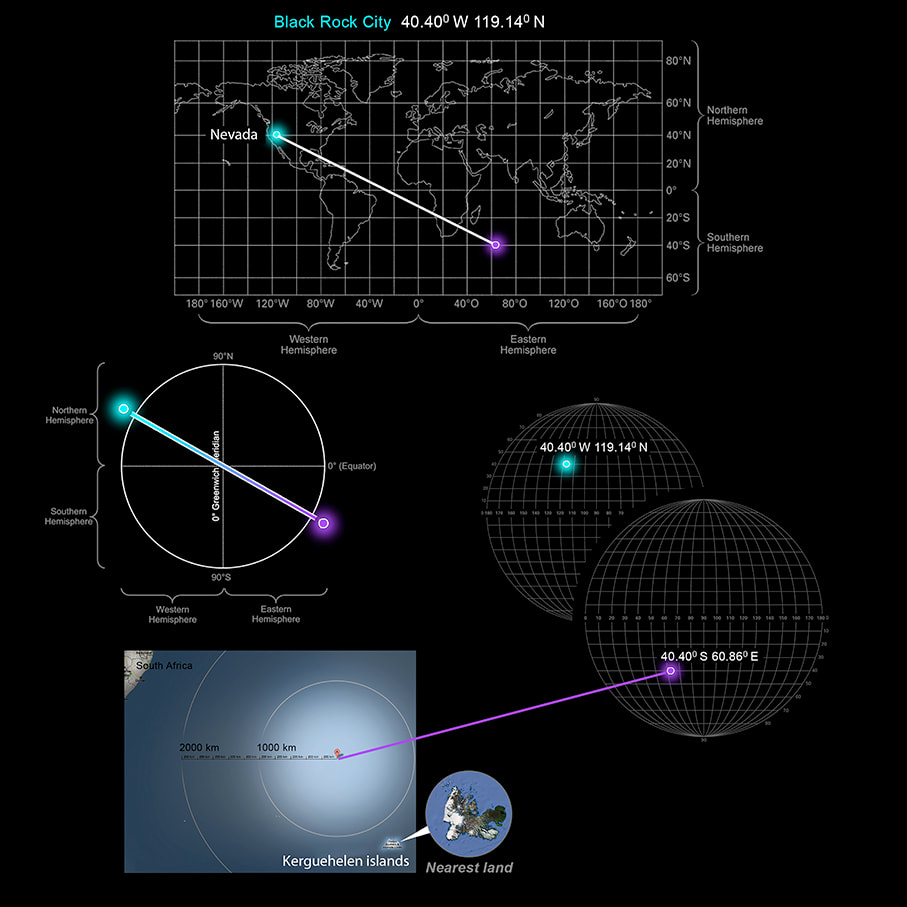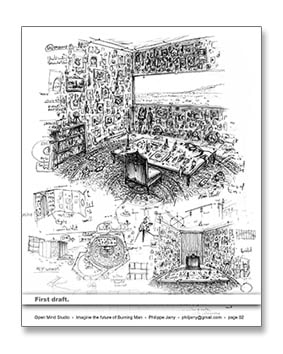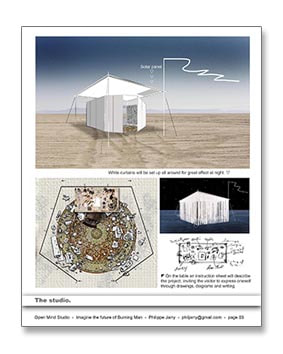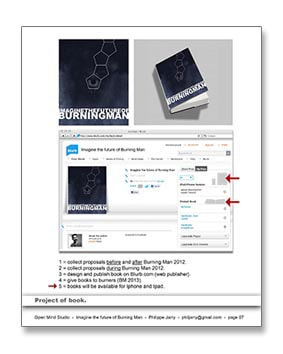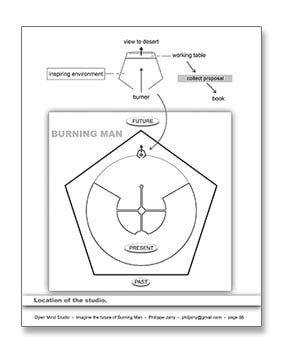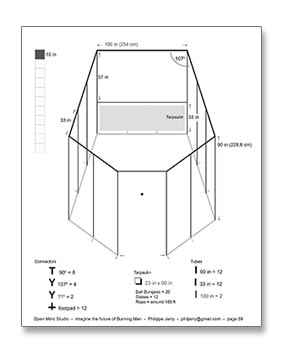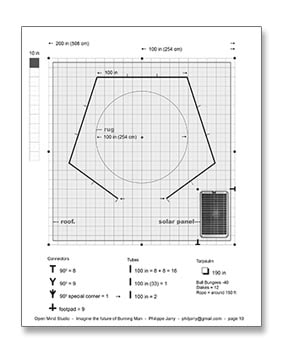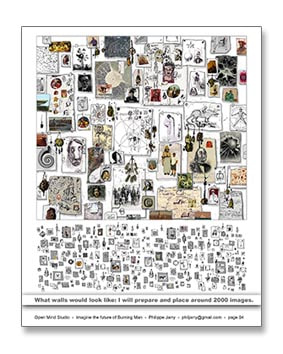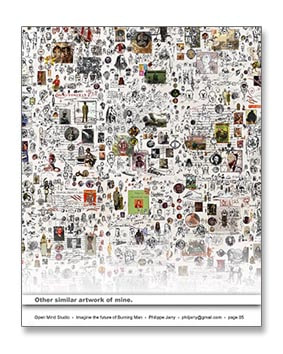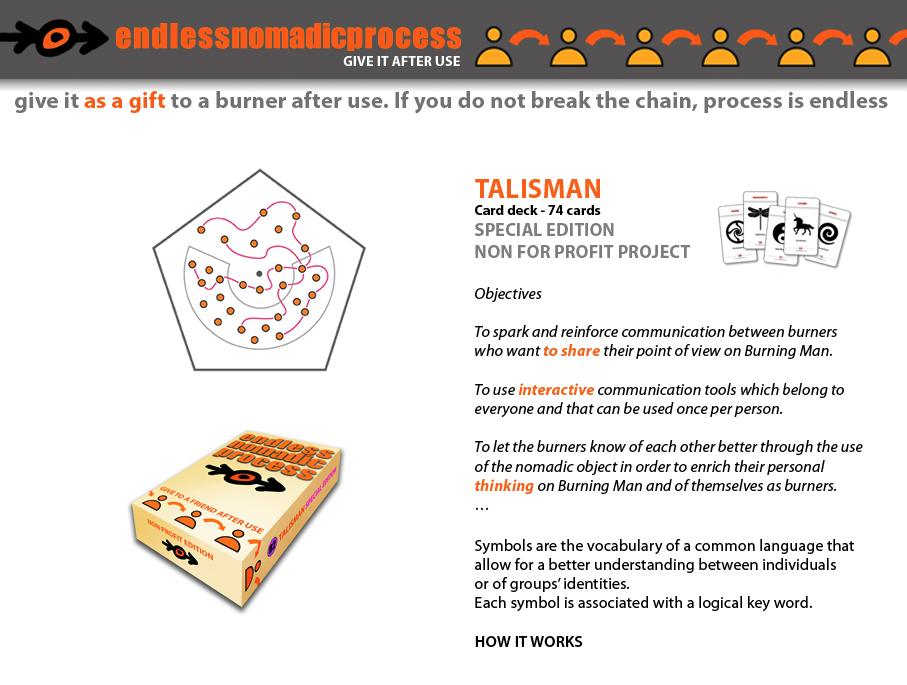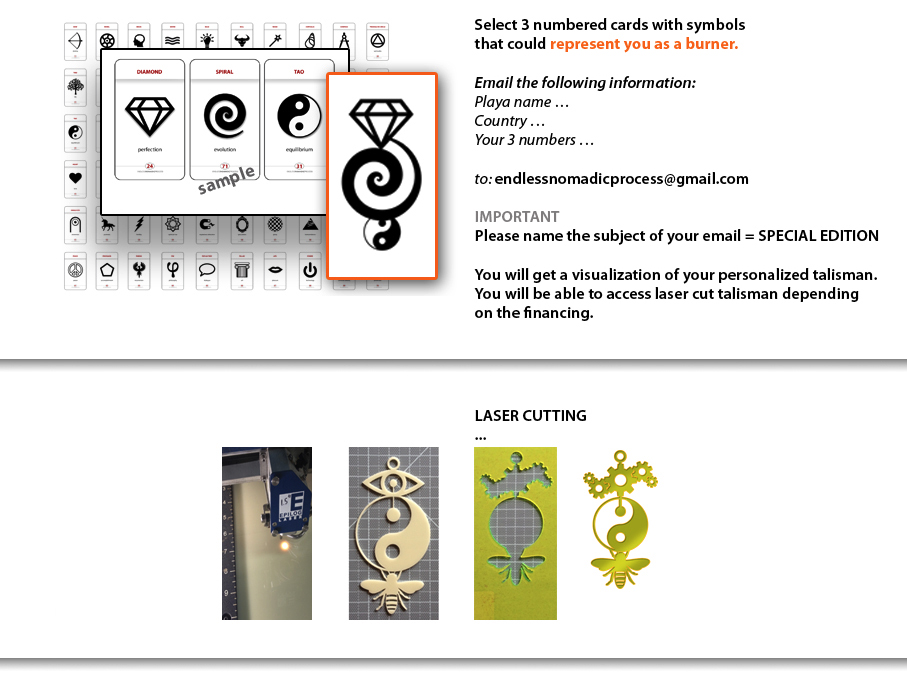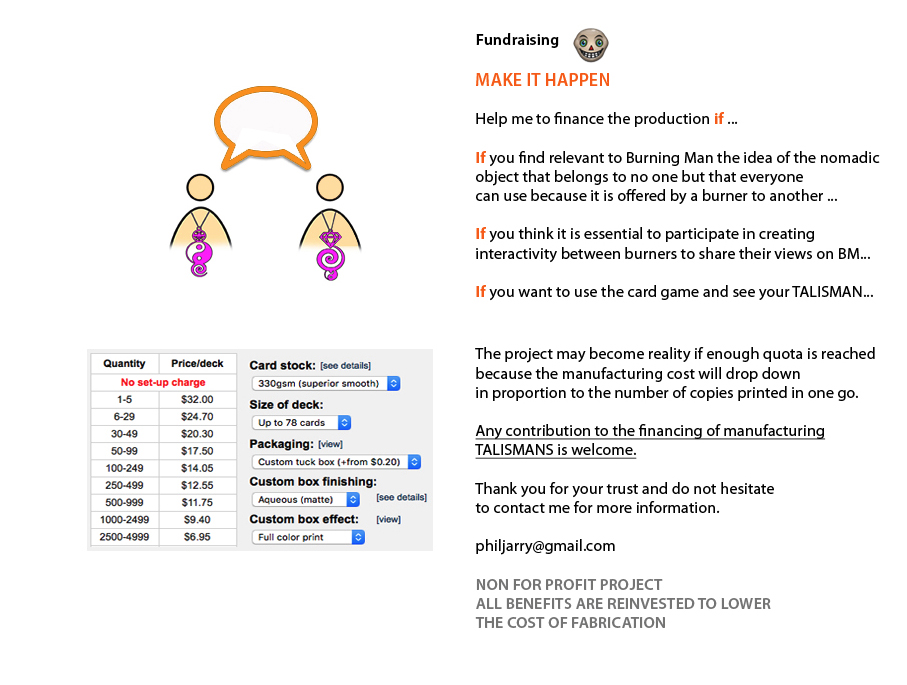EXTRA ARCHIVES
THE FUTUR OF BURNING MAN
TEXT AFTER IMAGES BELOW
A two-step commitment.
The first time at BM, it is subjective experience immediately accessible by the senses which prevails and not rational analysis in search of objectivity.
As with a thunderbolt, we are captivated and delighted to be by enjoying essentially the pleasures of discovering a gigantic party in the middle of nowhere.
We come back home in possession of a new energy by promising ourselves to come back next year.
Most of us then understand the need to change our habits to achieve 2 objectives: first, import as much as possible the spirit of BM throughout the year and then, get involved in a project if possible within a collective.
It is here, I believe, that one can see the true expression of the genius of Larry Harvey who will have aroused so many stories of friendship (sometimes very long) within groups spontaneously emerging to serve a deeply humanist cause, spiritually enriching and philosophically exciting.
The second time at BM, our natural penchant for rationalization, perpetually in search of meaning, takes over and people (including me) question the effective adequacy between what BM claims to be and reality.
This is the crucial moment of lucidity allowing the validation of one's own participation.
We assess the relevance and compatibility of our commitment with the idea that we have of the spirit of BM as we think we understood it and by respecting the rules of the game.
We leave BRC a second time having all the elements to choose which project to undertake in order to truly contribute to the common aim.
The main strength of Burning Man.
From the artistic and intellectual movements of the counter culture of the 60s and 70s, BM inherited the desire to shape an alternative model to a society based on consumerism which corrupts souls, destroys the environment and glamorize individualism in its narrowly selfish version.
BM is really the only large-scale experiment of a utopia essentially advocating humanist values like tolerance, freedom of expression and sharing.
The ten principles stated in the form of users guide, the prohibition of monetary exchanges, the recommendation of Do It Yourself and ecological concerns are the axioms which one cannot turn away from without taking the risk of distorting the trajectory of BM.
The goals of this original utopia coincide with the aspirations of all of us who dream again and again of another more humanly tolerable world.
Since its creation, everything confirms to us that BM is more relevant than ever and that the responsibility is immense for a unique laboratory of its kind allowing finally to modulate reality according to different frequencies.
The essential ritual.
The Man can be understood as a negative allegory of the individual prisoner of the human being trapped in today’s society, becoming positive during liberating cremation.
Anyone can project a part of themselves that should be burned.
We all have, to varying degrees, a share of responsibility for the not very shiny state of the world and the ritual of fire will allow us to operate an awareness by identifying this share of complicity.
From so many different cultures we have always celebrated the mystery of transmutation with fire by offering a symbolic object to the flames that will pass through the blaze from one state to another.
The desired effect is always the same: to provoke a catharsis (from the Greek: purification) in order to feel delivered from a fatal passion by means of a dramaturgy.
A burning object does not disappear instantly; it transforms into particles of light which fly away at night to mix with the stars, reveals its glowing core when it becomes embers, is nothing more than a memory of smoking ashes in the early morning the day after...
These transformations in successive stages, whose show fascinates, provokes a kind of waking dream in which thoughts are freed in part from the weight of rationalism.
Fire is not only a destructive force because its spectacle encourages creative meditation on the possibility of being reborn after having sacrificed part of yourself.
At Burning Man, the ceremony being a collective event, we do not feel alone and abandoned in this important moment, then everyone keeps the secret of what was burned in him that year ...
Throughout the week, other fire rituals take place burning ephemeral artworks (sometimes of impressive size) which are kind of extensions of the Man momentarily attracting attention on a more specific symbolic object.
The temple.
Believer, agnostic or atheist, everyone can take the time here for a religious or philosophical meditation on the mysteries of the existence and purpose of all things or simply feel the vibrations of a peaceful collective energy to find in itself a new truth or a balance in the forces which connect it to the whole cosmos.
The Temple is therefore a neutral space whose charge becomes positive by the mere presence of the beings visiting it.
The main use that is made of the Temple is a tribute to the memory of missing loved ones as evidenced by the presence of messages addressed to them (small papers, graffiti, objects, etc.).
In opposition to the vitality that is expressed day and night in Burning Man, the temple offers not a morbid worship of the dead but a redefinition of our fragility. Can we actually feel alive, in a festive and creative mood by ignoring a mourning whose trial has marked us?
It is sometimes said that a person is really dead when no one thinks of him anymore and it is perhaps the refusal of this darkness which is ultimately the basis of all spiritual practice.
In the middle of the desert, is it not the best place to reinitialize this desire for spirituality by putting back in its right place this aspiration, as old as humanity, at the heart of each individual and not framed by obsolete religious systems or circumscribed in the promise of scientist transhumanism's immortality?
When the Temple ignites then collapses on itself in an infernal blaze, the spectacle almost eclipses the ritual of the Man on fire the day before.
However, we do not necessarily see the interest of this cremation requiring to accept a huge waste of wood.
Being rather animist, I tend to think that no human construction dedicated to a form of spirituality can compete with nature and the Temple does not matter to me even if I can understand its importance for others and that we can preserve a place dedicated to posthumous memory.
But I would prefer that it be dismantled for recycling because burning it seems completely meaningless unless the priority is to entertain the crowd by offering a final show which, in my view, is not necessary.
Structural inconsistencies.
Nothing is more disappointing than enduring the traffic jam for hours to access BM and then seeing the omnipresence of thousands of cars and RV on the site.
Money has disappeared at BM but not the most trivial polluting symbol of the consumer society.
One would have thought that BRC would be more like an ephemeral city made up of tent camps bristling with solar panels and windmill, each having their own way, taking up the challenge of self-sufficiency associated with DIY in a collective effort framed by principles.
BM should push the art of camping to its highest point of sophistication by abandoning all types of motor vehicles in an off-site parking area connected to a shuttle system.
The container solution, also off-site, should also be generalized to store everything that is stupid to travel every year: tools, tents, evolving artwork, various essential materials, etc.
Where is the counter-model of the inegalitarian society and waste when you are softened in the cocoon of your air-conditioned unnecessarily spacious RV?
Where is the idea of reinventing a balance between the assessment of one's real needs and a quest for autonomy in a virgin space like the desert?
Where are the innovations combining the ingenuity of DIY and the relevant use of new clean technologies stemming from ecological research?
The amount of electrical energy production at BM is like everywhere else and at all times, mainly conditioned by ever greater comfort needs that unfortunately no one dares to question ...
We could logically think that electricity consumption should be proportional to the capacity to produce it properly for needs revised downwards (possibly authorizing few exceptions according to criteria to be discussed).
Non-fossil energy may be able to save us from global warming but are also very polluting; that’s why BM’s challenge will be (still for a long time) to think of the intelligent balance between sobriety and a controlled expenditure of energy.
How to reconcile on the one hand the electrical voracity of sound systems as well as the proliferation of LEDs supposed to transform every night into an nonesuch party and on the other hand a constructive criticism of blind consumerism?
It is not a question of excluding electro music but of questioning its hegemony by promoting the reintegration of all forms of un-plug music ...
Although their omnipresence becomes almost tiresome and often linked to batteries (of which we will not recall here the industrial manufacturing processes in contradiction with the most elementary preservation of the environment), LEDs have a high brightness / energy ratio and therefore very attractive.
But if each camp had its own campfire, much of the lighting problem (with so many creative paths to explore) would be solved by producing extra welcome heat at BRC at night.
Since the dawn of time, humanity has been able to reinvent festive rituals without gorging on electricity…
Night clubbing with all its light clichés imported at all costs to BM looks like a chronic disease to which we are too easily accustomed.
We are well aware that the success of a festive collective event depends less on the means implemented than on the quantity and quality of positive waves emitted by each participant...
What the point to self-congratulate at the end of BM during the pickup of the last silver glitter trailing on the ground while the festival will have generally taken a significant part in the usual energy waste for a week and sometimes all year long in the preparation of some projects where the lack of will to think the ecological cost is obvious?
Individual inconsistencies.
Before going to BM we can understand that we are tempted to buy (as usual on the internet without worrying where the product is coming from) a piece of clothing or an accessory “perfect for Burning Man” and apparently many burners are compulsive consumers and spend incessantly.
Some luxurious outfits reveal at least a misunderstanding of the overall project and at worst a misconception of DIY which is not to be ingenious and creative on Amazon!
Furthermore, how do artists respect the principle of decommodification by effectively prohibiting any personal promotion?
Shouldn't DJs refrain from posting their performance on BRC on their youtube channel and refuse to have their names mentioned, especially on a lineup available online?
Isn't anonymity the first obvious bulwark against all temptations to self-promote?
This is also true for artworks on Playa which must not become a commercial showcase to which the price of the BM ticket gives access one week per year.
As an artist, BM’s challenge is to create an ephemeral work in indirect relation to the usual production in order to avoid the publicity inherent in the repetition of an identifiable style.
It is not a question of realizing, as usual (for most artists) a work for oneself alone, but a work offered to all in perfect harmony with the spirit of BM and if possible within a collective.
Ideally, right from the start of project design, there is a group discussion to determine what is worth undertaking based on skills pooled.
Nevertheless, an artist can remain the author of the initial proposal if his friends are convinced and enthusiastic but not by proclaiming himself leader since it is about his idea, his talent, unfortunately sometimes even his money ...
The German artist Joseph Beuys gave a definition of what a social art could have been if one recognized the value of anyone who participates, even in fulfilling the most humble task, in a collective work.
The artist must seize the rare opportunity to put aside his ego risking a plunge into creative interactivity.
As a spectator it is important to feel that at Burning Man, artistic intentions are neither conditioned by the expectations of the institutional art world nor corrupted by the financial logic of the art market.
The future of BM.
Burning Man is an exceptional place where 75,000 human beings reject the unequal consumerist capitalist system by initiating an alternative model of human relationships and social organization.
The interpersonal relationships at BRC are indeed different and as we would dream that they should be all year long: systematically peaceful, warmhearted, free from numerous and cumbersome inhibitions, innovative, surprising, creative ...
Social organization, despite all the indisputable qualities of BM, seems to suffer negative distortions requiring correction but which seem tolerated, neglected, even encouraged...
The fragile vision of a desirable future society loses its relevance, its force and its attractiveness if huge exceptions to the principles become the rule.
The first time at BM, it is subjective experience immediately accessible by the senses which prevails and not rational analysis in search of objectivity.
As with a thunderbolt, we are captivated and delighted to be by enjoying essentially the pleasures of discovering a gigantic party in the middle of nowhere.
We come back home in possession of a new energy by promising ourselves to come back next year.
Most of us then understand the need to change our habits to achieve 2 objectives: first, import as much as possible the spirit of BM throughout the year and then, get involved in a project if possible within a collective.
It is here, I believe, that one can see the true expression of the genius of Larry Harvey who will have aroused so many stories of friendship (sometimes very long) within groups spontaneously emerging to serve a deeply humanist cause, spiritually enriching and philosophically exciting.
The second time at BM, our natural penchant for rationalization, perpetually in search of meaning, takes over and people (including me) question the effective adequacy between what BM claims to be and reality.
This is the crucial moment of lucidity allowing the validation of one's own participation.
We assess the relevance and compatibility of our commitment with the idea that we have of the spirit of BM as we think we understood it and by respecting the rules of the game.
We leave BRC a second time having all the elements to choose which project to undertake in order to truly contribute to the common aim.
The main strength of Burning Man.
From the artistic and intellectual movements of the counter culture of the 60s and 70s, BM inherited the desire to shape an alternative model to a society based on consumerism which corrupts souls, destroys the environment and glamorize individualism in its narrowly selfish version.
BM is really the only large-scale experiment of a utopia essentially advocating humanist values like tolerance, freedom of expression and sharing.
The ten principles stated in the form of users guide, the prohibition of monetary exchanges, the recommendation of Do It Yourself and ecological concerns are the axioms which one cannot turn away from without taking the risk of distorting the trajectory of BM.
The goals of this original utopia coincide with the aspirations of all of us who dream again and again of another more humanly tolerable world.
Since its creation, everything confirms to us that BM is more relevant than ever and that the responsibility is immense for a unique laboratory of its kind allowing finally to modulate reality according to different frequencies.
The essential ritual.
The Man can be understood as a negative allegory of the individual prisoner of the human being trapped in today’s society, becoming positive during liberating cremation.
Anyone can project a part of themselves that should be burned.
We all have, to varying degrees, a share of responsibility for the not very shiny state of the world and the ritual of fire will allow us to operate an awareness by identifying this share of complicity.
From so many different cultures we have always celebrated the mystery of transmutation with fire by offering a symbolic object to the flames that will pass through the blaze from one state to another.
The desired effect is always the same: to provoke a catharsis (from the Greek: purification) in order to feel delivered from a fatal passion by means of a dramaturgy.
A burning object does not disappear instantly; it transforms into particles of light which fly away at night to mix with the stars, reveals its glowing core when it becomes embers, is nothing more than a memory of smoking ashes in the early morning the day after...
These transformations in successive stages, whose show fascinates, provokes a kind of waking dream in which thoughts are freed in part from the weight of rationalism.
Fire is not only a destructive force because its spectacle encourages creative meditation on the possibility of being reborn after having sacrificed part of yourself.
At Burning Man, the ceremony being a collective event, we do not feel alone and abandoned in this important moment, then everyone keeps the secret of what was burned in him that year ...
Throughout the week, other fire rituals take place burning ephemeral artworks (sometimes of impressive size) which are kind of extensions of the Man momentarily attracting attention on a more specific symbolic object.
The temple.
Believer, agnostic or atheist, everyone can take the time here for a religious or philosophical meditation on the mysteries of the existence and purpose of all things or simply feel the vibrations of a peaceful collective energy to find in itself a new truth or a balance in the forces which connect it to the whole cosmos.
The Temple is therefore a neutral space whose charge becomes positive by the mere presence of the beings visiting it.
The main use that is made of the Temple is a tribute to the memory of missing loved ones as evidenced by the presence of messages addressed to them (small papers, graffiti, objects, etc.).
In opposition to the vitality that is expressed day and night in Burning Man, the temple offers not a morbid worship of the dead but a redefinition of our fragility. Can we actually feel alive, in a festive and creative mood by ignoring a mourning whose trial has marked us?
It is sometimes said that a person is really dead when no one thinks of him anymore and it is perhaps the refusal of this darkness which is ultimately the basis of all spiritual practice.
In the middle of the desert, is it not the best place to reinitialize this desire for spirituality by putting back in its right place this aspiration, as old as humanity, at the heart of each individual and not framed by obsolete religious systems or circumscribed in the promise of scientist transhumanism's immortality?
When the Temple ignites then collapses on itself in an infernal blaze, the spectacle almost eclipses the ritual of the Man on fire the day before.
However, we do not necessarily see the interest of this cremation requiring to accept a huge waste of wood.
Being rather animist, I tend to think that no human construction dedicated to a form of spirituality can compete with nature and the Temple does not matter to me even if I can understand its importance for others and that we can preserve a place dedicated to posthumous memory.
But I would prefer that it be dismantled for recycling because burning it seems completely meaningless unless the priority is to entertain the crowd by offering a final show which, in my view, is not necessary.
Structural inconsistencies.
Nothing is more disappointing than enduring the traffic jam for hours to access BM and then seeing the omnipresence of thousands of cars and RV on the site.
Money has disappeared at BM but not the most trivial polluting symbol of the consumer society.
One would have thought that BRC would be more like an ephemeral city made up of tent camps bristling with solar panels and windmill, each having their own way, taking up the challenge of self-sufficiency associated with DIY in a collective effort framed by principles.
BM should push the art of camping to its highest point of sophistication by abandoning all types of motor vehicles in an off-site parking area connected to a shuttle system.
The container solution, also off-site, should also be generalized to store everything that is stupid to travel every year: tools, tents, evolving artwork, various essential materials, etc.
Where is the counter-model of the inegalitarian society and waste when you are softened in the cocoon of your air-conditioned unnecessarily spacious RV?
Where is the idea of reinventing a balance between the assessment of one's real needs and a quest for autonomy in a virgin space like the desert?
Where are the innovations combining the ingenuity of DIY and the relevant use of new clean technologies stemming from ecological research?
The amount of electrical energy production at BM is like everywhere else and at all times, mainly conditioned by ever greater comfort needs that unfortunately no one dares to question ...
We could logically think that electricity consumption should be proportional to the capacity to produce it properly for needs revised downwards (possibly authorizing few exceptions according to criteria to be discussed).
Non-fossil energy may be able to save us from global warming but are also very polluting; that’s why BM’s challenge will be (still for a long time) to think of the intelligent balance between sobriety and a controlled expenditure of energy.
How to reconcile on the one hand the electrical voracity of sound systems as well as the proliferation of LEDs supposed to transform every night into an nonesuch party and on the other hand a constructive criticism of blind consumerism?
It is not a question of excluding electro music but of questioning its hegemony by promoting the reintegration of all forms of un-plug music ...
Although their omnipresence becomes almost tiresome and often linked to batteries (of which we will not recall here the industrial manufacturing processes in contradiction with the most elementary preservation of the environment), LEDs have a high brightness / energy ratio and therefore very attractive.
But if each camp had its own campfire, much of the lighting problem (with so many creative paths to explore) would be solved by producing extra welcome heat at BRC at night.
Since the dawn of time, humanity has been able to reinvent festive rituals without gorging on electricity…
Night clubbing with all its light clichés imported at all costs to BM looks like a chronic disease to which we are too easily accustomed.
We are well aware that the success of a festive collective event depends less on the means implemented than on the quantity and quality of positive waves emitted by each participant...
What the point to self-congratulate at the end of BM during the pickup of the last silver glitter trailing on the ground while the festival will have generally taken a significant part in the usual energy waste for a week and sometimes all year long in the preparation of some projects where the lack of will to think the ecological cost is obvious?
Individual inconsistencies.
Before going to BM we can understand that we are tempted to buy (as usual on the internet without worrying where the product is coming from) a piece of clothing or an accessory “perfect for Burning Man” and apparently many burners are compulsive consumers and spend incessantly.
Some luxurious outfits reveal at least a misunderstanding of the overall project and at worst a misconception of DIY which is not to be ingenious and creative on Amazon!
Furthermore, how do artists respect the principle of decommodification by effectively prohibiting any personal promotion?
Shouldn't DJs refrain from posting their performance on BRC on their youtube channel and refuse to have their names mentioned, especially on a lineup available online?
Isn't anonymity the first obvious bulwark against all temptations to self-promote?
This is also true for artworks on Playa which must not become a commercial showcase to which the price of the BM ticket gives access one week per year.
As an artist, BM’s challenge is to create an ephemeral work in indirect relation to the usual production in order to avoid the publicity inherent in the repetition of an identifiable style.
It is not a question of realizing, as usual (for most artists) a work for oneself alone, but a work offered to all in perfect harmony with the spirit of BM and if possible within a collective.
Ideally, right from the start of project design, there is a group discussion to determine what is worth undertaking based on skills pooled.
Nevertheless, an artist can remain the author of the initial proposal if his friends are convinced and enthusiastic but not by proclaiming himself leader since it is about his idea, his talent, unfortunately sometimes even his money ...
The German artist Joseph Beuys gave a definition of what a social art could have been if one recognized the value of anyone who participates, even in fulfilling the most humble task, in a collective work.
The artist must seize the rare opportunity to put aside his ego risking a plunge into creative interactivity.
As a spectator it is important to feel that at Burning Man, artistic intentions are neither conditioned by the expectations of the institutional art world nor corrupted by the financial logic of the art market.
The future of BM.
Burning Man is an exceptional place where 75,000 human beings reject the unequal consumerist capitalist system by initiating an alternative model of human relationships and social organization.
The interpersonal relationships at BRC are indeed different and as we would dream that they should be all year long: systematically peaceful, warmhearted, free from numerous and cumbersome inhibitions, innovative, surprising, creative ...
Social organization, despite all the indisputable qualities of BM, seems to suffer negative distortions requiring correction but which seem tolerated, neglected, even encouraged...
The fragile vision of a desirable future society loses its relevance, its force and its attractiveness if huge exceptions to the principles become the rule.
OPEN MIND STUDIO PROJECT
ENDLESS NOMADIC PROCESS PROJECT
texte en français plus bas
Be part of the solution, not part of the problem.
Actions ranked in order of importance but everyone must establish their priorities according to their possibilities of personal commitment.
1
Keep this list as a reminder of the actions to be carried out.
Calculate your carbon footprint.
Change your habits now and make the right decisions for the long term to significantly reduce your carbon footprint.
2
Give up owning a car, it's possible for the majority of citizen living in large cities.
(renting a vehicle sometimes (if necessary) is so less expensive than buying...)
3
Reduce journeys by promoting public transport and carpooling.
Use the bike as much as possible.
Drastically limit long plane trips (to 1 or 2 flights per year maximum).
4
Invest in the insulation of your home (if necessary).
Lower the heating by adding a sweater, in winter.
Adapt as much as possible to a minimum of air conditioning in summer.
5
Significantly reduce all non-essential purchases.
Do not waste food, electricity, water (in water-stressed regions).
Make objects last as long as possible by repairing them, especially household appliances.
To new clothes, prefer mending (if possible) and second hand.
Make your computer, tablet, smartphone last, skipping as many versions as possible.
Very rarely order online.
6
Ban plastic in all its forms.
Sorting waste and composting.
Do not get rid of household appliances at the end of their life, but know the recycling circuits in your city.
Buy household cleaning products that are not harmful to the environment.
Wash your clothes in cold water and hang them up.
7
Do your own cooking daily.
If possible, consume organic, local and seasonal food products.
Use a shopping bag.
Eat very little meat (maximum 1 or 2 times a month)
Buying the best high-end origin-controlled meat once in a while is much cheaper than the bad one 3 times a week).
Do not eat endangered fish species (salmon, bluefin tuna, cod).
Prioritize non-animal food.
8
Avoid restaurants because they process (almost all) cheap products from the food industry.
Do not order food delivered to your home for the same refusal to swallow the worst of industrial production and also to limit unnecessary travel.
9
Significantly reduce the time of use of computers, tablets, smartphones.
Limit internet traffic generated by social networks, digital TV and video streaming.
Store your data on an external hard drive rather than on energy-intensive cloud servers.
Avoid crypto-currencies which increase the carbon impact of digital which is already excessive.
10
Support associations to the extent of its means (donations and volunteering).
Share ideas with those around you.
Engage more actively.
Être une partie de la solution et non du problème.
Actions classées par ordre d’importance mais chacun doit établir ses priorités en fonction de ses possibilités d’engagement personnel.
1
Garder cette liste comme références en mémo des actions à mener.
Calculer son empreinte carbone (nosgestesclimat.fr)
Changer ses habitudes dès maintenant et prendre les bonnes décisions pour le long terme afin de réduire significativement son empreinte carbone.
2
Renoncer à posséder une voiture.
C’est possible pour la majorité des citadins des grandes ville.
Louer un véhicule quelque fois (si nécessaire) est bien plus économique que l’acquisition et l’entretien de sa propre voiture.
3
Diminuer les trajets en favorisant les transports en commun, le covoiturage.
Utiliser le vélo le plus possible.
Limiter drastiquement les longs trajets en avion (à 1 ou 2 vol par an maximum).
4
Investir dans l’isolation de son logement (si nécessaire).
Baisser le chauffage en ajoutant un pull, l’hiver.
S’adapter autant que possible à un minimum de climatisation, l’été.
5
Diminuer significativement tous les achats non indispensables.
Ne pas gaspiller la nourriture, l’électricité, l’eau (dans les régions en situation de stress hydrique).
Faire durer le plus possible les objets en les réparant, notamment l’électroménager.
Aux vêtement neufs, préférer le raccommodage (si possible) et la seconde main.
Faire durer ordinateur, tablette, smartphone, en sautant le plus de versions possible.
Ne commander que très rarement via internet.
6
Bannir le plastique sous toutes ses formes.
Faire le tri des déchets et le compostage.
Ne pas se débarrasser n'importe comment des appareils ménagers en fin de vie mais connaitre dans sa ville les circuits de recyclage.
Acheter les produits d’entretien ménagers qui ne sont pas nocifs pour l’environnement..
Laver son linge à l’eau froide et l’étendre.
7
Faire soi-même la cuisine quotidiennement.
Si possible, consommer les produits alimentaires bio, locaux et de saisons.
Utiliser un sac de course.
Manger très peu de viande (maximum 1 ou 2 fois par mois)
Acheter la meilleure viande haut de gamme à l’origine contrôlée de temps en temps revient beaucoup moins cher que la mauvaise 3 fois par semaine).
Ne pas manger les espèces de poissons menacées (saumon, thon rouge, morue).
Privilégier l’alimentation non-animal.
8
Eviter les restaurants car ils transforment (quasiment tous) les produits bas de gamme de l’industrie alimentaire.
Ne pas commander de nourriture livrée à domicile pour le même refus d’avaler le pire de la production industrielle et aussi pour limiter les déplacements inutiles.
9
Réduire significativement le temps d’utilisation des ordinateurs, tablettes, smartphones.
Limiter le trafic internet engendré par les réseaux sociaux, la TV numérique et le streaming video.
Stocker ses données sur un disque dur externe plutôt que sur les serveurs énergivore du cloud.
Eviter les crypto-monnaies qui augmente l’impact carbone du numérique qui est déjà excessif.
10
Soutenir les associations dans la mesure de ses moyens (dons et bénévolat).
Partager les idées avec son entourage.
S’engager plus activement.
Be part of the solution, not part of the problem.
Actions ranked in order of importance but everyone must establish their priorities according to their possibilities of personal commitment.
1
Keep this list as a reminder of the actions to be carried out.
Calculate your carbon footprint.
Change your habits now and make the right decisions for the long term to significantly reduce your carbon footprint.
2
Give up owning a car, it's possible for the majority of citizen living in large cities.
(renting a vehicle sometimes (if necessary) is so less expensive than buying...)
3
Reduce journeys by promoting public transport and carpooling.
Use the bike as much as possible.
Drastically limit long plane trips (to 1 or 2 flights per year maximum).
4
Invest in the insulation of your home (if necessary).
Lower the heating by adding a sweater, in winter.
Adapt as much as possible to a minimum of air conditioning in summer.
5
Significantly reduce all non-essential purchases.
Do not waste food, electricity, water (in water-stressed regions).
Make objects last as long as possible by repairing them, especially household appliances.
To new clothes, prefer mending (if possible) and second hand.
Make your computer, tablet, smartphone last, skipping as many versions as possible.
Very rarely order online.
6
Ban plastic in all its forms.
Sorting waste and composting.
Do not get rid of household appliances at the end of their life, but know the recycling circuits in your city.
Buy household cleaning products that are not harmful to the environment.
Wash your clothes in cold water and hang them up.
7
Do your own cooking daily.
If possible, consume organic, local and seasonal food products.
Use a shopping bag.
Eat very little meat (maximum 1 or 2 times a month)
Buying the best high-end origin-controlled meat once in a while is much cheaper than the bad one 3 times a week).
Do not eat endangered fish species (salmon, bluefin tuna, cod).
Prioritize non-animal food.
8
Avoid restaurants because they process (almost all) cheap products from the food industry.
Do not order food delivered to your home for the same refusal to swallow the worst of industrial production and also to limit unnecessary travel.
9
Significantly reduce the time of use of computers, tablets, smartphones.
Limit internet traffic generated by social networks, digital TV and video streaming.
Store your data on an external hard drive rather than on energy-intensive cloud servers.
Avoid crypto-currencies which increase the carbon impact of digital which is already excessive.
10
Support associations to the extent of its means (donations and volunteering).
Share ideas with those around you.
Engage more actively.
Être une partie de la solution et non du problème.
Actions classées par ordre d’importance mais chacun doit établir ses priorités en fonction de ses possibilités d’engagement personnel.
1
Garder cette liste comme références en mémo des actions à mener.
Calculer son empreinte carbone (nosgestesclimat.fr)
Changer ses habitudes dès maintenant et prendre les bonnes décisions pour le long terme afin de réduire significativement son empreinte carbone.
2
Renoncer à posséder une voiture.
C’est possible pour la majorité des citadins des grandes ville.
Louer un véhicule quelque fois (si nécessaire) est bien plus économique que l’acquisition et l’entretien de sa propre voiture.
3
Diminuer les trajets en favorisant les transports en commun, le covoiturage.
Utiliser le vélo le plus possible.
Limiter drastiquement les longs trajets en avion (à 1 ou 2 vol par an maximum).
4
Investir dans l’isolation de son logement (si nécessaire).
Baisser le chauffage en ajoutant un pull, l’hiver.
S’adapter autant que possible à un minimum de climatisation, l’été.
5
Diminuer significativement tous les achats non indispensables.
Ne pas gaspiller la nourriture, l’électricité, l’eau (dans les régions en situation de stress hydrique).
Faire durer le plus possible les objets en les réparant, notamment l’électroménager.
Aux vêtement neufs, préférer le raccommodage (si possible) et la seconde main.
Faire durer ordinateur, tablette, smartphone, en sautant le plus de versions possible.
Ne commander que très rarement via internet.
6
Bannir le plastique sous toutes ses formes.
Faire le tri des déchets et le compostage.
Ne pas se débarrasser n'importe comment des appareils ménagers en fin de vie mais connaitre dans sa ville les circuits de recyclage.
Acheter les produits d’entretien ménagers qui ne sont pas nocifs pour l’environnement..
Laver son linge à l’eau froide et l’étendre.
7
Faire soi-même la cuisine quotidiennement.
Si possible, consommer les produits alimentaires bio, locaux et de saisons.
Utiliser un sac de course.
Manger très peu de viande (maximum 1 ou 2 fois par mois)
Acheter la meilleure viande haut de gamme à l’origine contrôlée de temps en temps revient beaucoup moins cher que la mauvaise 3 fois par semaine).
Ne pas manger les espèces de poissons menacées (saumon, thon rouge, morue).
Privilégier l’alimentation non-animal.
8
Eviter les restaurants car ils transforment (quasiment tous) les produits bas de gamme de l’industrie alimentaire.
Ne pas commander de nourriture livrée à domicile pour le même refus d’avaler le pire de la production industrielle et aussi pour limiter les déplacements inutiles.
9
Réduire significativement le temps d’utilisation des ordinateurs, tablettes, smartphones.
Limiter le trafic internet engendré par les réseaux sociaux, la TV numérique et le streaming video.
Stocker ses données sur un disque dur externe plutôt que sur les serveurs énergivore du cloud.
Eviter les crypto-monnaies qui augmente l’impact carbone du numérique qui est déjà excessif.
10
Soutenir les associations dans la mesure de ses moyens (dons et bénévolat).
Partager les idées avec son entourage.
S’engager plus activement.


